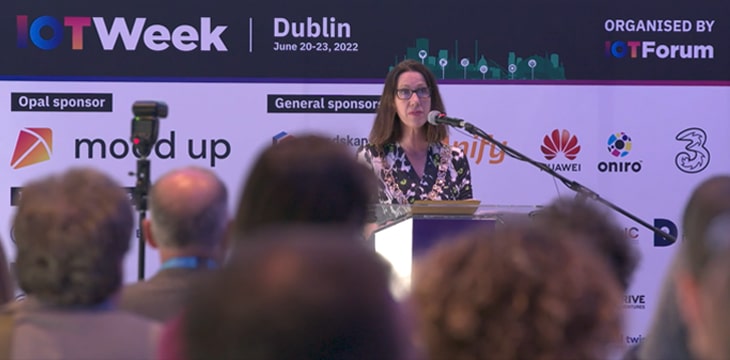|
Getting your Trinity Audio player ready...
|
https://www.youtube.com/watch?v=3DpocpagLUU
Dublin’s IoT Week finally kicked off on June 20, 2022, an event originally scheduled for 2020, but was rescheduled twice due to COVID-related complications.
Spirits were high during the opening reception, the Lord Mayor of Dublin herself even made an appearance and welcomed delegates with open arms for the first time in two years.
“We have 600 amazing delegates. IoT is something that we very much promote as a city. We’ve integrated it into our way of working as a local government, so it’s fantastic. I look forward to learning more from the discussions that are happening here and also for meeting some of our delegates,” Lord Mayor Alison Gilliland shared with me.
The Global IoT Summit was a big part of Dublin’s IoT week’s educational schedule, featuring both Latif Ladid, President of the IPv6 Forum and Dr. Craig Wright, Chief Scientist of nChain, as keynote speakers. The pair covered limitations in IPv4 (internet protocol version four) and how Dr. Wright’s vision of Bitcoin and the ability to do peer to peer transactions will allow the improved IPv6 to reach its full potential.
During Ladid’s keynote, he explained how the internet’s original end-to-end model has been disrupted, the consequences of the disruption and why IPv6 is necessary for an IoT-powered world.
“Now between people is not secure. That’s why even our emails are not secure. This is really very bad,” elaborated Ladid after his presentation.
“But I think IPv6 will restore the end-to-end model which allows us in this case to go for very large-scale applications. And one of them is, in this case, blockchain and BSV,” he revealed.
Immediately following Ladid’s keynote, Dr. Wright delivered his keynote speech, diving into how Bitcoin allows for users of the internet to communicate directly and go back to the functionality we can achieve with IPv6.

“You can actually scale things out, fragment and store parts of the network all over the place rather than having large central servers, Facebook, Google, Amazon. Of course, now you can actually have everything stored in a distributed manner, the way that the Internet was originally promised to be,” Dr. Wright said in his speech.
“The original implementation [of Bitcoin] that I released in 2009 is very different to what you see now. The methodology that people stopped deploying was basically a person directly communicated with the IP address of another person. By doing that, that’s how you have peer to peer that allows you to scale very, very quickly and very easily,” he explained.
“With IoT devices, this is going to become more and more important,” Dr. Wright added.
In addition to covering the synergies between IPv6 and the original Bitcoin protocol, the Global IoT Summit featured a handful of panels with a blockchain focus, including how the technology can alleviate pain points in food supply chain.
“Basically the current scheme we have now in the food supply chain is very inefficient, if not its very lousy,” Ladid said, moderator of two blockchain and food supply chain panels at the event.
“We have already a Ponzi scheme in the food supply chain…and the reason for it is that although we have regulations, the regulators know how to fix these things, but they don’t have the tools to track and trace these things,” Ladid explained.
“So we have to create these tools for the regulator to identify, verify, track and trace where these products are coming from and so on. And I think there is immense work to be done in this area”, he said.
Srdjan Krco, CEO of DunavNET and VP of IoT Forum, spoke on one of Ladid’s panels and talked on the blockchain-based solutions that are currently being worked on within the food supply chain space.
“For blockchain perspectives, one of the partners in the consortium is our colleagues from OriginTrail or Trace Labs, and they are working in this blockchain domain for quite many years. And what we are now using in the project and what they are also building outside of the project is this sophisticated knowledge graph which sits on top of a blockchain layer,” Krco revealed.
“We use this knowledge graph as a way where we can kind of store a subset of data and make it searchable and use blockchain at the bottom to make it immutable and trustable,” he said.
While the use of blockchain technology for food supply chain and in partnership with IPv6 sounds perfect in theory, professionals working in the IoT space still have a lot to learn about blockchain, how it can help their projects and what the misconceptions are.
“There’s no doubt right now its public knowledge and a lot of the knowledge, it is there,” said Subhasis Thakur, Research Fellow, National University of Ireland, of the delegates’ familiarity with blockchain.
“Basically, there is a misconception that whatever we put in the blockchain is correct, so that has to be corrected. The data you put in the blockchain may not be correct. So you need additional steps, additional vetting, a decent audit procedure to ensure that what you put in the blockchain, that it is correct,” he advised.
“In this place, [delegates] are more IoT, they are researchers in the IoT sector, they have never associated it with what they can do with blockchain,” added Ladid.
“Especially with what’s happening with BTC, it’s scaring many. That’s why they are not ready to touch it. These are reasonable people. They don’t fall in those traps,” he said.
“So now we’re seeing that what we joked about is that maybe the BTC bubble is going to explode just a couple of months ago, now it has happened. Nobody is talking about it. It was a real crash,” Ladid added.
Watch: Dr. Craig Wright’s keynote at Global IoT Summit in Dublin
https://www.youtube.com/watch?v=Xv3fvQP8sMk&feature=youtu.be

 12-25-2025
12-25-2025 




